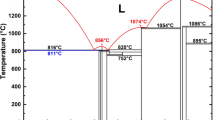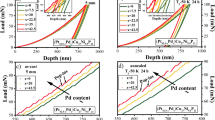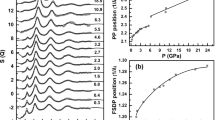Abstract
In many amorphous and glassy systems the local structure seems to be essentially the same in amorphous and crystalline phases. It thus becomes possible to define a ‘local structural unit’, such as the SiO4 group in silicates. Determination of the structure then reduces to the problem of describing how the local units are connected and packed in the medium-range structure. There is mounting evidence that alloys of transition metals with metalloids are more adequately described by arrangements of stereo-chemically-defined structural units than by alternative descriptions in terms of random packing of atoms. There are three phases, Fe3C, Ti3P and Fe3P, which may serve as models of local structural units. These lattices differ to a small degree in the symmetry of the metalloid nearest-neighbour shell but there are major differences in the arrangement of local structural units. Although the experimental evidence is limited, it seems that the distinctive features of the local and medium-range topologies of the crystalline phases are represented in the structures of each of the corresponding glasses.
This is a preview of subscription content, access via your institution
Access options
Subscribe to this journal
Receive 51 print issues and online access
$199.00 per year
only $3.90 per issue
Buy this article
- Purchase on Springer Link
- Instant access to full article PDF
Prices may be subject to local taxes which are calculated during checkout
Similar content being viewed by others
References
Gaskell, P. H. Nature 276, 484–5 (1978).
Gaskell, P. H. J. Non-Cryst. Solids 32, 207–24 (1979).
Suzuki, K., Fukunaga, T., Misawa, M. & Masumoto, T. Science Rep. Inst. Tohoku Univ. 26A, 1–11 (1976).
Fukunaga, T., Misawa, M., Fukamichi, K. & Suzuki, K. in Rapidly Quenched Metals III Vol. 2 (ed. Cantor, B.) 325–329 (Metals Society, London, 1978).
Sadoc, J. F. & Dixmier, J. in The Structure of Non-Crystalline Materials (ed.Gaskell, P. H.) 85–88 (Taylor & Francis, London 1977).
Sadoc, J. F. & Dixmier, J. Mater. Sci. Engng. 23, 187–92 (1976).
Chi, G. C. & Cargill,, G. S. III J. appl. Phys. 50, 2713–20 (1979).
Durand, J. & Yung, M. in Amorphous Magnetism II (eds Levy, R. A. & Hasegawa, R.) 275 (Plenum, New York, 1977).
Luborsky, F. E. in Ferromagnetic Materials Vol. l (ed. Wohlfahrt, E. P.) 451–530 (North-Holland, Amsterdam, 1980).
Panissod, P. et al. Phys. Rev. Lett. 44, 1465–68 (1980).
Author information
Authors and Affiliations
Rights and permissions
About this article
Cite this article
Gaskell, P. Similarities in amorphous and crystalline transition metal–metalloid alloy structures. Nature 289, 474–476 (1981). https://doi.org/10.1038/289474a0
Received:
Accepted:
Issue Date:
DOI: https://doi.org/10.1038/289474a0
This article is cited by
-
A medium-range structure motif linking amorphous and crystalline states
Nature Materials (2021)
-
Average Co magnetic moment of R-Co-B (R = Y, Pr and Nd) compounds
Journal of Materials Science (2005)
-
Microstructure, crystallization, and coercivity of rare earth-iron-boron amorphous alloy ribbons
Metallurgical Transactions A (1990)
-
Radiation-induced structural changes in alloys
Pramana (1985)
Comments
By submitting a comment you agree to abide by our Terms and Community Guidelines. If you find something abusive or that does not comply with our terms or guidelines please flag it as inappropriate.



